Krishna Kanth Nakka
NAT: Learning to Attack Neurons for Enhanced Adversarial Transferability
Aug 23, 2025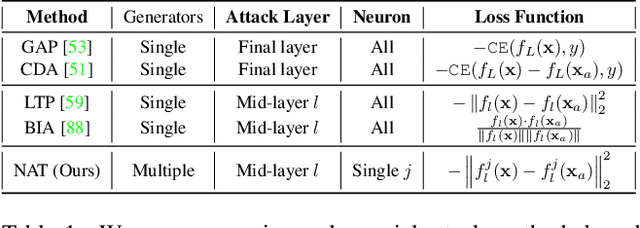

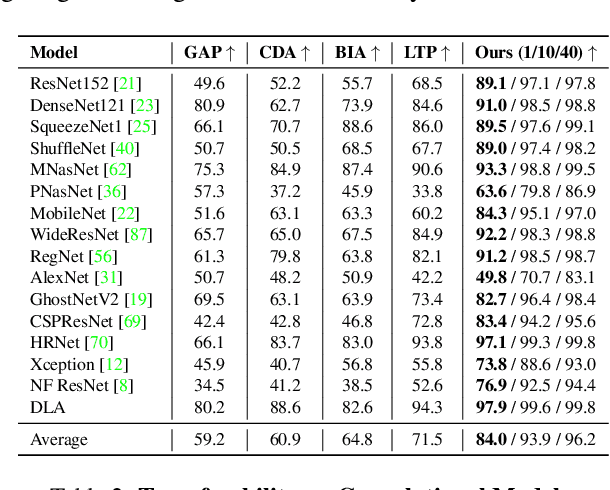

Abstract:The generation of transferable adversarial perturbations typically involves training a generator to maximize embedding separation between clean and adversarial images at a single mid-layer of a source model. In this work, we build on this approach and introduce Neuron Attack for Transferability (NAT), a method designed to target specific neuron within the embedding. Our approach is motivated by the observation that previous layer-level optimizations often disproportionately focus on a few neurons representing similar concepts, leaving other neurons within the attacked layer minimally affected. NAT shifts the focus from embedding-level separation to a more fundamental, neuron-specific approach. We find that targeting individual neurons effectively disrupts the core units of the neural network, providing a common basis for transferability across different models. Through extensive experiments on 41 diverse ImageNet models and 9 fine-grained models, NAT achieves fooling rates that surpass existing baselines by over 14\% in cross-model and 4\% in cross-domain settings. Furthermore, by leveraging the complementary attacking capabilities of the trained generators, we achieve impressive fooling rates within just 10 queries. Our code is available at: https://krishnakanthnakka.github.io/NAT/
PrivacyScalpel: Enhancing LLM Privacy via Interpretable Feature Intervention with Sparse Autoencoders
Mar 14, 2025



Abstract:Large Language Models (LLMs) have demonstrated remarkable capabilities in natural language processing but also pose significant privacy risks by memorizing and leaking Personally Identifiable Information (PII). Existing mitigation strategies, such as differential privacy and neuron-level interventions, often degrade model utility or fail to effectively prevent leakage. To address this challenge, we introduce PrivacyScalpel, a novel privacy-preserving framework that leverages LLM interpretability techniques to identify and mitigate PII leakage while maintaining performance. PrivacyScalpel comprises three key steps: (1) Feature Probing, which identifies layers in the model that encode PII-rich representations, (2) Sparse Autoencoding, where a k-Sparse Autoencoder (k-SAE) disentangles and isolates privacy-sensitive features, and (3) Feature-Level Interventions, which employ targeted ablation and vector steering to suppress PII leakage. Our empirical evaluation on Gemma2-2b and Llama2-7b, fine-tuned on the Enron dataset, shows that PrivacyScalpel significantly reduces email leakage from 5.15\% to as low as 0.0\%, while maintaining over 99.4\% of the original model's utility. Notably, our method outperforms neuron-level interventions in privacy-utility trade-offs, demonstrating that acting on sparse, monosemantic features is more effective than manipulating polysemantic neurons. Beyond improving LLM privacy, our approach offers insights into the mechanisms underlying PII memorization, contributing to the broader field of model interpretability and secure AI deployment.
PII-Scope: A Benchmark for Training Data PII Leakage Assessment in LLMs
Oct 09, 2024



Abstract:In this work, we introduce PII-Scope, a comprehensive benchmark designed to evaluate state-of-the-art methodologies for PII extraction attacks targeting LLMs across diverse threat settings. Our study provides a deeper understanding of these attacks by uncovering several hyperparameters (e.g., demonstration selection) crucial to their effectiveness. Building on this understanding, we extend our study to more realistic attack scenarios, exploring PII attacks that employ advanced adversarial strategies, including repeated and diverse querying, and leveraging iterative learning for continual PII extraction. Through extensive experimentation, our results reveal a notable underestimation of PII leakage in existing single-query attacks. In fact, we show that with sophisticated adversarial capabilities and a limited query budget, PII extraction rates can increase by up to fivefold when targeting the pretrained model. Moreover, we evaluate PII leakage on finetuned models, showing that they are more vulnerable to leakage than pretrained models. Overall, our work establishes a rigorous empirical benchmark for PII extraction attacks in realistic threat scenarios and provides a strong foundation for developing effective mitigation strategies.
PII-Compass: Guiding LLM training data extraction prompts towards the target PII via grounding
Jul 03, 2024



Abstract:The latest and most impactful advances in large models stem from their increased size. Unfortunately, this translates into an improved memorization capacity, raising data privacy concerns. Specifically, it has been shown that models can output personal identifiable information (PII) contained in their training data. However, reported PIII extraction performance varies widely, and there is no consensus on the optimal methodology to evaluate this risk, resulting in underestimating realistic adversaries. In this work, we empirically demonstrate that it is possible to improve the extractability of PII by over ten-fold by grounding the prefix of the manually constructed extraction prompt with in-domain data. Our approach, PII-Compass, achieves phone number extraction rates of 0.92%, 3.9%, and 6.86% with 1, 128, and 2308 queries, respectively, i.e., the phone number of 1 person in 15 is extractable.
IncogniText: Privacy-enhancing Conditional Text Anonymization via LLM-based Private Attribute Randomization
Jul 03, 2024



Abstract:In this work, we address the problem of text anonymization where the goal is to prevent adversaries from correctly inferring private attributes of the author, while keeping the text utility, i.e., meaning and semantics. We propose IncogniText, a technique that anonymizes the text to mislead a potential adversary into predicting a wrong private attribute value. Our empirical evaluation shows a reduction of private attribute leakage by more than 90%. Finally, we demonstrate the maturity of IncogniText for real-world applications by distilling its anonymization capability into a set of LoRA parameters associated with an on-device model.
ObfuscaTune: Obfuscated Offsite Fine-tuning and Inference of Proprietary LLMs on Private Datasets
Jul 03, 2024Abstract:This work addresses the timely yet underexplored problem of performing inference and finetuning of a proprietary LLM owned by a model provider entity on the confidential/private data of another data owner entity, in a way that ensures the confidentiality of both the model and the data. Hereby, the finetuning is conducted offsite, i.e., on the computation infrastructure of a third-party cloud provider. We tackle this problem by proposing ObfuscaTune, a novel, efficient and fully utility-preserving approach that combines a simple yet effective obfuscation technique with an efficient usage of confidential computing (only 5% of the model parameters are placed on TEE). We empirically demonstrate the effectiveness of ObfuscaTune by validating it on GPT-2 models with different sizes on four NLP benchmark datasets. Finally, we compare to a na\"ive version of our approach to highlight the necessity of using random matrices with low condition numbers in our approach to reduce errors induced by the obfuscation.
Understanding Pose and Appearance Disentanglement in 3D Human Pose Estimation
Sep 20, 2023Abstract:As 3D human pose estimation can now be achieved with very high accuracy in the supervised learning scenario, tackling the case where 3D pose annotations are not available has received increasing attention. In particular, several methods have proposed to learn image representations in a self-supervised fashion so as to disentangle the appearance information from the pose one. The methods then only need a small amount of supervised data to train a pose regressor using the pose-related latent vector as input, as it should be free of appearance information. In this paper, we carry out in-depth analysis to understand to what degree the state-of-the-art disentangled representation learning methods truly separate the appearance information from the pose one. First, we study disentanglement from the perspective of the self-supervised network, via diverse image synthesis experiments. Second, we investigate disentanglement with respect to the 3D pose regressor following an adversarial attack perspective. Specifically, we design an adversarial strategy focusing on generating natural appearance changes of the subject, and against which we could expect a disentangled network to be robust. Altogether, our analyses show that disentanglement in the three state-of-the-art disentangled representation learning frameworks if far from complete, and that their pose codes contain significant appearance information. We believe that our approach provides a valuable testbed to evaluate the degree of disentanglement of pose from appearance in self-supervised 3D human pose estimation.
Temporally-Transferable Perturbations: Efficient, One-Shot Adversarial Attacks for Online Visual Object Trackers
Dec 30, 2020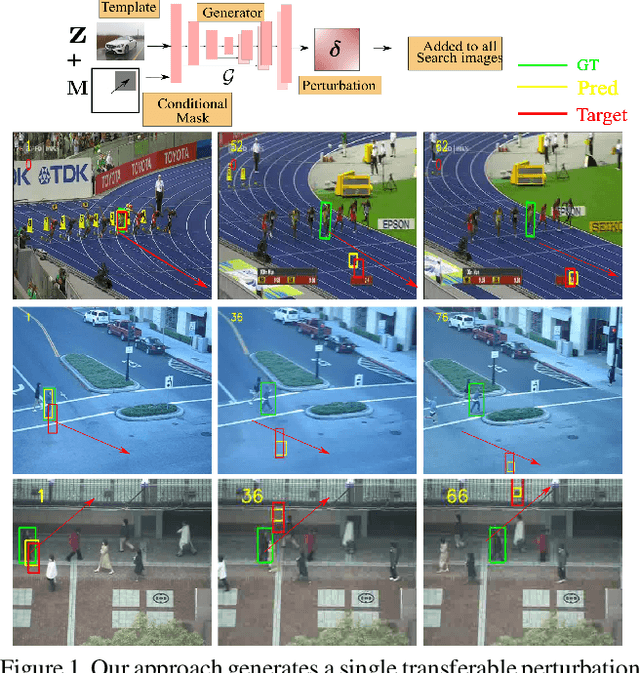
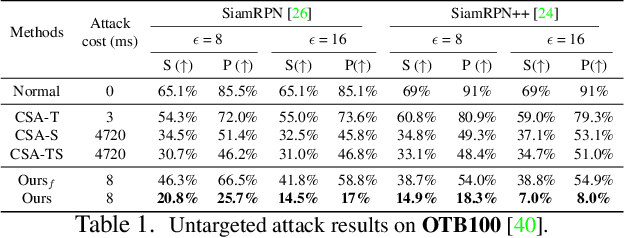

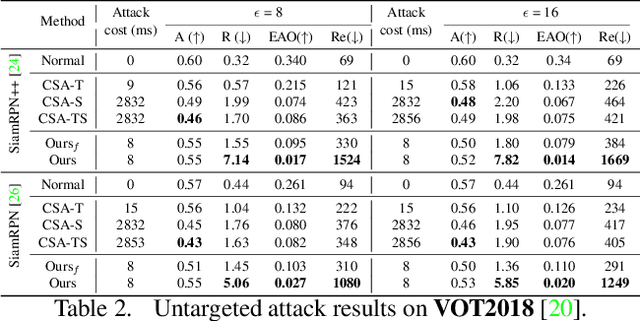
Abstract:In recent years, the trackers based on Siamese networks have emerged as highly effective and efficient for visual object tracking (VOT). While these methods were shown to be vulnerable to adversarial attacks, as most deep networks for visual recognition tasks, the existing attacks for VOT trackers all require perturbing the search region of every input frame to be effective, which comes at a non-negligible cost, considering that VOT is a real-time task. In this paper, we propose a framework to generate a single temporally transferable adversarial perturbation from the object template image only. This perturbation can then be added to every search image, which comes at virtually no cost, and still, successfully fool the tracker. Our experiments evidence that our approach outperforms the state-of-the-art attacks on the standard VOT benchmarks in the untargeted scenario. Furthermore, we show that our formalism naturally extends to targeted attacks that force the tracker to follow any given trajectory by precomputing diverse directional perturbations.
Towards Robust Fine-grained Recognition by Maximal Separation of Discriminative Features
Jun 10, 2020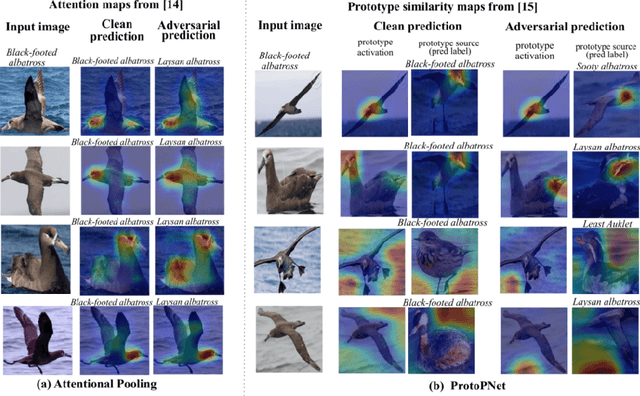
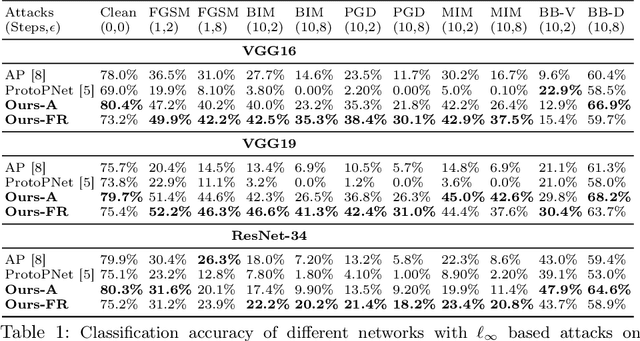
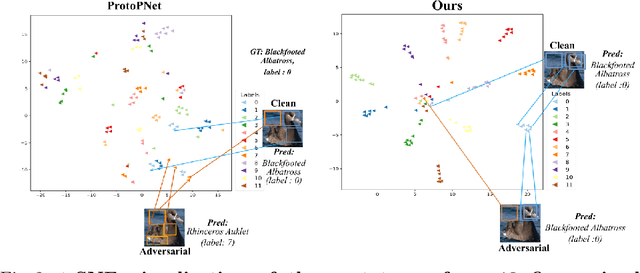
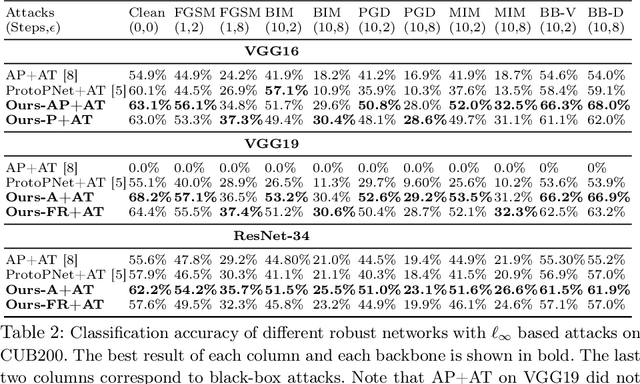
Abstract:Adversarial attacks have been widely studied for general classification tasks, but remain unexplored in the context of fine-grained recognition, where the inter-class similarities facilitate the attacker's task. In this paper, we identify the proximity of the latent representations of different classes in fine-grained recognition networks as a key factor to the success of adversarial attacks. We therefore introduce an attention-based regularization mechanism that maximally separates the discriminative latent features of different classes while minimizing the contribution of the non-discriminative regions to the final class prediction. As evidenced by our experiments, this allows us to significantly improve robustness to adversarial attacks, to the point of matching or even surpassing that of adversarial training, but without requiring access to adversarial samples.
Indirect Local Attacks for Context-aware Semantic Segmentation Networks
Dec 02, 2019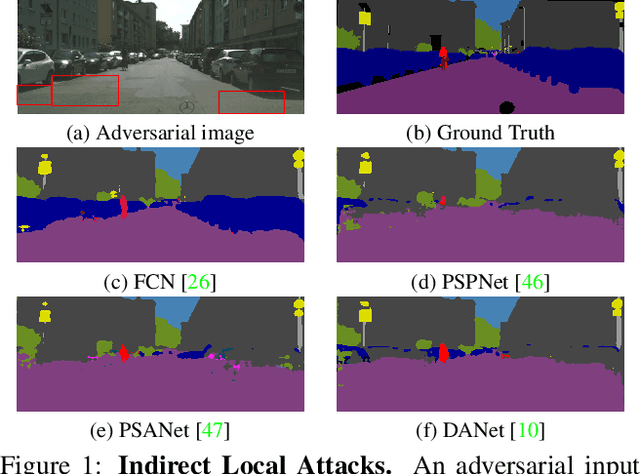

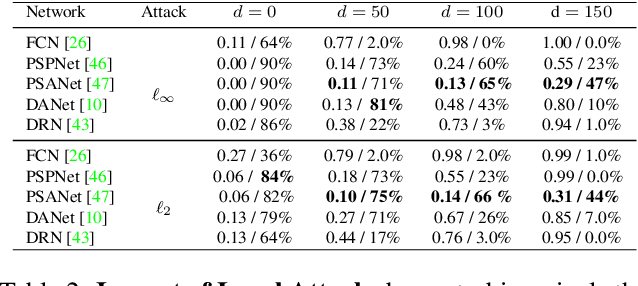
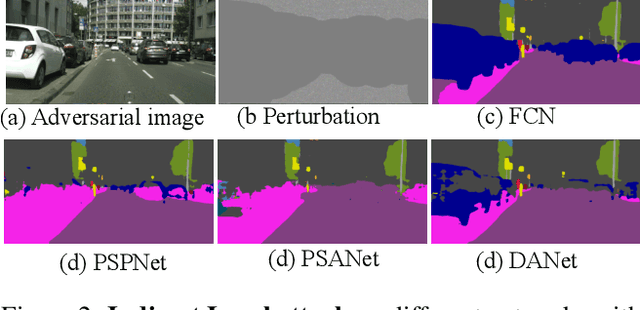
Abstract:Recently, deep networks have achieved impressive semantic segmentation performance, in particular thanks to their use of larger contextual information. In this paper, we show that the resulting networks are sensitive not only to global attacks, where perturbations affect the entire input image, but also to indirect local attacks where perturbations are confined to a small image region that does not overlap with the area that we aim to fool. To this end, we introduce several indirect attack strategies, including adaptive local attacks, aiming to find the best image location to perturb, and universal local attacks. Furthermore, we propose attack detection techniques both for the global image level and to obtain a pixel-wise localization of the fooled regions. Our results are unsettling: Because they exploit a larger context, more accurate semantic segmentation networks are more sensitive to indirect local attacks.
 Add to Chrome
Add to Chrome Add to Firefox
Add to Firefox Add to Edge
Add to Edge